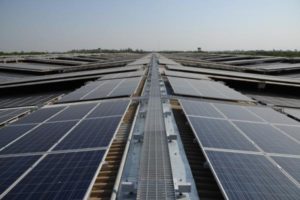
Manikaran Solar Ltd (MSL) is an affiliate of Manikaran Group, one of the largest power trading companies in India. MSL caters to the entire value chain of solar open access and rooftop projects by working closely with consumers and developers. Aditya Malpani closely explains how Manikaran Solar engages with stakeholders to structure bankable power purchase agreements. While admitting that solar energy is currently facing some challenges, Malpani is confident that MSL will build a portfolio of over 300 mw in the next 2-3 years.
Please summarize the activities of Manikaran Solar in the field of solar energy.
Established in 2016, Manikaran Solar Ltd (MSL) is an affiliate of Manikaran Power Ltd, one of the largest power trading companies in India. The Group not only has extensive reach with consumers across country but also have deep expertise in entire value chain of open access.
MSL aims to build a powerful business development engine in the field of renewable open access. We work with consumers, investors, discoms and regulatory bodies to develop sustainable framework for renewable open access in lines with Electricity Act 2003 across country including states which may see renewable open access for first time in Punjab and Haryana.
Today, we have one of the largest pipeline of bankable power off-take arrangement in northern India. We are in process of raising strategic investment to build state of art portfolio of Open Access assets in India.
We learn that Manikaran Solar specializes in structuring bankable long-term PPAs. Tell us more on how you bring together consumers and developers, and how the “Open Access” policy has been a facilitator of such deals.
In my view, a bankable off-take contract should fulfil the following minimum criteria:
- Clear demarcation and appropriation of all open access costs from project bus-bar to consumer periphery between project company and offtaker
- Contract should provide transparent sharing framework for all the regulatory risks as applicable today
- Contract should also incorporate all the possible scenarios of future risks i.e. imposition of new charges or losses, restriction/removal on energy banking, imposition of UI charges etc
- Contract should meet all requirements as laid down in Electricity Act 2003 and Electricity Rules 2005 in letter and spirit
- Since contract enforceability in India is not very high, off-taker should have fair amount of skin in the project
The basic components of renewable open access business model can be summarized as follows:
- Floor Price: Minimum price secured in the contract has to be secluded from any market risks. Revenues from floor price shall ensure minimum cash flow required for SPV to be remain solvent through the tenure of contract
- Return on Equity: This is the margin that an investor should expect on return on equity employed. We strive to deliver around 16-17 per cent return on equity where important risks are being borne by off-takers. Further, as investor may take additional regulatory risks, return profile should accordingly be adjusted.
- Open Access Costs: This should consider all open access costs for fetching electricity from Project Bus Bar to Consumer periphery. A bankable contract should ensure that contracts are viable for both parties even in the case when all open access costs are levied to full extent (without policy incentives) for the entire tenure of contract.
- Savings: This is the incentive for consumers to enter into long term contracts with project developers.
A bankable contract requires thorough and transparent discussion on entire risk framework. Further, considerations such as payment security mechanism and proper termination clause further help the cause.
MSL undertakes considerable efforts to ensure that consumers have fair understanding of all risks associated with entering into long term contract. Further, we work with consumers and investor to mitigate all possible residual risks.
Solar tariffs are rapidly falling, at least for large grid-connected solar power plants. How would you gauge the impact of falling tariffs on long-term PPAs?
Our view is that rapidly falling solar tariffs is a widely known phenomenon. Both consumers and investors understand that solar tariffs may decline in future. Still, we have seen considerably amount of sincere interest on both sides to evaluate this business model.
We mitigate above risks through following measures:
- For large scale consumer, we propose to develop projects in a phase-wise manner. This ensures best possible levelized cost of energy for consumers for the period. For example, in Haryana, we are working with a consumer having contract demand beyond 100 mw. We are in process of developing projects in multiple phases of 30-mw each.
- We try to bring substantial financial involvement of consumers through equity investment by client, appropriate payment security built in the contract, and a clearly-defined termination clause
We believe that our contract effectively ensures that only a serious consumer who intends to honor the contract for entire duration, signs up with us.
What is your view on the renewable energy service company (RESCO) model for small rooftop installations? Do you organize RESCO deals?
 We are also acting as facilitators for RESCO and capex transactions in rooftop space. As far as challenges for RESCOs in the rooftop business are concerned, I would say that scalability is one. Since the average ticket size of rooftop RESCO transactions is in the 500kW to 1mw range, it is a big challenge for developers to build operational capabilities beyond a certain scale. My opinion is that beyond a particular size it requires state-of-art operational framework to smoothly manage the supply and payment cycle for long duration of contracts.
We are also acting as facilitators for RESCO and capex transactions in rooftop space. As far as challenges for RESCOs in the rooftop business are concerned, I would say that scalability is one. Since the average ticket size of rooftop RESCO transactions is in the 500kW to 1mw range, it is a big challenge for developers to build operational capabilities beyond a certain scale. My opinion is that beyond a particular size it requires state-of-art operational framework to smoothly manage the supply and payment cycle for long duration of contracts.
Contract enforceability is also a concern. Since developers have very limited recourse after a rooftop project is commissioned, client selection and load profile assessment are quite important.
Also the current net metering policy allows maximum of 1-nw of rooftop projects to be installed. This is a huge bottleneck as many industrial scale consumers may not be able utlilize full potential.
Do you feel that with a favourable policy in place, net metering could promote solar rooftop installations?
Net metering policy plays pivotal role in promotion of rooftop projects as solar generation and power consumption are mutually exclusive events. An appropriate net metering policy ensures that solar generation is economically utilized even in a scenario where power is not being consumed.
However, implementation of net metering across states has not been encouraging. While on the one hand, discoms lack incentives to encourage any such possible generation, they also need capacity building at the last mile in the value chain so that consumers/developers may get hassle free net metering facility.
Do you feel that solar energy represents a good avenue for green-energy investors? Please discuss.
Currently, solar generation is going through an important inflexion point. After falling costs for straight several years, the sector is currently facing some challenges. Module prices have increased by more than 20 per cent after touching all time bottom of around 30 US cents per Watt. The likely imposition of anti dumping on imports of solar modules, and the imposition of GST are also concerns.
Hence, while cost of generation has taken an upswing, utility scale bids at ultra-low tariffs of Rs.2.44/kWh, have certainly created confusion among both off takers and investors.
However, open-access consumers realize that risks involved in B2B business are quite different from B2G projects. Therefore, tariff realization is also likely to be different. Consumers are pragmatic to understand that projects will take shape only when likely equity returns in this business is at least 16-17 per cent.
We believe that a state of art portfolio of B2B projects with high cash flows shall be an excellent value contributor and risk diversification tool for any developer looking for sustainable yield portfolio.
What is the current portfolio size of Manikaran Solar in terms of capacity-size of PPAs executed? How do you see the way forward?
Our total pipeline across Rajasthan, Haryana, Madhya Pradesh and Punjab is more than 100 mw. We are in process of raising strategic investment from leading private equity funds to build a portfolio of more than 300 mw in next 2-3 years.


